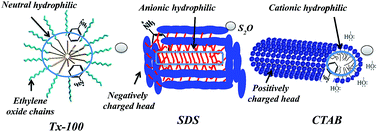Surfactant directed polyaniline nanostructures for high performance sulphur dioxide chemiresistors: effect of morphologies, chemical structure and porosity
Abstract
The present investigation explores the effect of the type of surfactant on the sulphur dioxide sensing behaviour of high surface area polyaniline nanostructures (HSPAN). Various HSPAN, possessing flake like structures (∼1–2 microns broad and diffused with a surface area of ∼578 482.0 cm2 g−1), fibrillar morphology (diameter ∼ 50 nm with a surface area of ∼1 101 500.0 cm2 g−1) and spherical morphology (diameter ∼ 50 nm with a surface area of ∼525 370.0 cm2 g−1) have been synthesized by template assisted chemical oxidation using sodium di-sulphate, SDS (an anionic surfactant), Triton-100 (a non-ionic surfactant), CTAB (a cationic surfactant), respectively. These prepared HSPAN have been tested for SO2 sensing and it is found that at room temperature (300 K) PAN nanofibres show the highest sensitivity (∼3.4%) for very low ppm levels (10 ppm) of sulphur dioxide than that of PAN nanoparticles (∼2%) and PAN flakes (∼0.88%). The enhanced sensing response exhibited by CTAB assisted nanofibres can be attributed to their higher oxidation sites, higher surface to volume ratio, larger pore volume and interconnected branched morphology. This study opens a new window for room temperature detection of SO2 by a cost effective chemiresistive type technique. Further, PAN nanofibres showed significant selectivity, stability, reproducibility and good detection limit towards SO2. The sensing mechanism is analysed by using in situ FTIR measurements.


 Please wait while we load your content...
Please wait while we load your content...